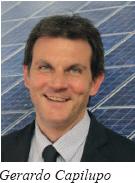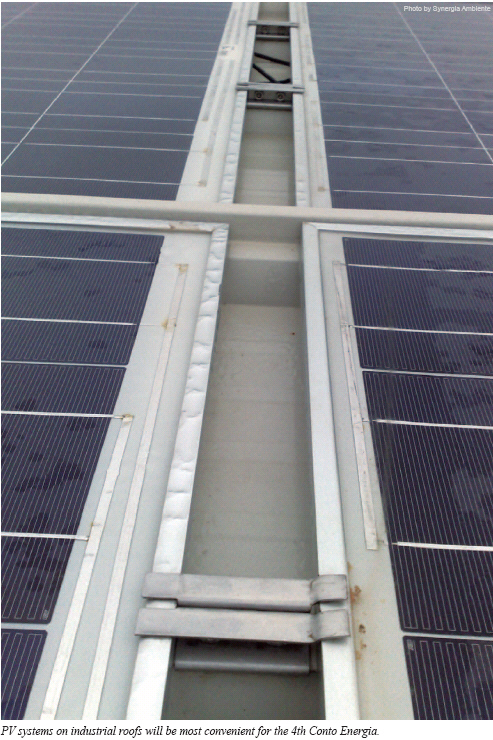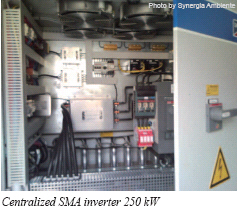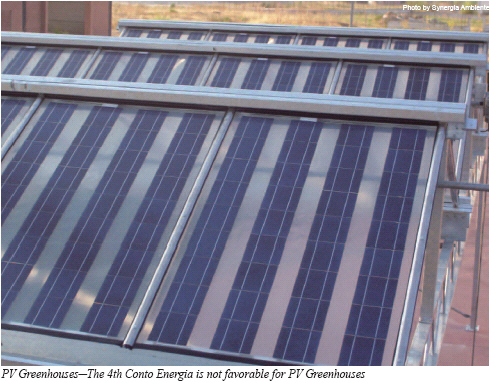By Gerardo Capilupo
.jpg)
 In Italy, during the first part of 2011, the turning outs of Renewable Energy Policy, and particularly the Romani Decree, published in March, after the name of the new Industry Minister, and by now widely known as the ¡®Renewable Killer Decree¡¯¦¡give once more the instance about how energy policy is dealt with, especially concerning energy savings and green technologies. In Italy, during the first part of 2011, the turning outs of Renewable Energy Policy, and particularly the Romani Decree, published in March, after the name of the new Industry Minister, and by now widely known as the ¡®Renewable Killer Decree¡¯¦¡give once more the instance about how energy policy is dealt with, especially concerning energy savings and green technologies.
After the expiry of the Second Feed in Tariff Scheme¦¡the so called Conto Energia¦¡at the end of December 2010, the third one, which was supposed to rule the PV incentives in Italy for 3 years until the end of 2013, lasted only 5 months. The booming 2010 saw an amazing 4 GW installed, especially thanks to the very condescending dispensation by the Salva Alcoa Decree, which admitted to the richer 2010 feed-in tariffs all systems declared completed¦¡opposite to the original law, which granted tariffs according to the time of connection to the national grid. That was much more than expected and triggered reactions of an important part of Industry Association, and a strong campaign against feed-in tariff law for photovoltaic. Money for paying photovoltaic tariffs is, in fact, gathered through consumers electricity bill¦¡part of the total price of energy from the grid goes in supporting schemes for renewable. On-grid photovoltaic systems, with its generous tariffs and those massively increasing numbers scared big energy consumers, fearing their electricity bill to get unsustainably expensive due to the growth of PV grants.
Despite the reasons for stopping the third Conto Energia, and the evaluation, for several aspects even positive, of the fourth one, it is the way the whole affair was handled that left bitterness and confusion, and which caused not easily reversible damages to the market and, even more, spread uncertainty about the future of supporting schemes for photovoltaic and green technologies.

Italian PV Industry, one of the oldest in Europe, but still far behind the most important ones, always must have faced¦¡and suffered from¦¡insecurity, passing through very strong demand (often depressed by raw materials shortages), alternated with low production; in such a context, Italian industrial chain could not develop in time and in the correct way to join European competition properly; it could not benefit, as it was for German companies, which are now leaders alongside Asian bigs, by a domestic market to get bigger and getting ready for the international scene. The Romani Decree has had, furthermore, the obvious effect of paralyzing the Italian market for more than three months, a more serious one which will be kept for a long time as a threatening precedent; effectively it has suddenly cancelled, without a reasonable notice period, the third Conto Energia¦¡which was supposed to rule the market for three years and on which enterprises¦¡and investors¦¡relied and give money to it. Banks and Funds suspended payment and investments, most of the ongoing projects had to stop, waiting for the new law and tariffs values, and distrust spreads pushing investors to look at other markets, more stable and certain, like the U.S.A. or South Africa. The thing is: If Mr. Romani did, once again, some new minister will be able to do it. How could investments, even on a short and medium term, be planned? Italian sun cannot be attractive if there is no trust on a stable law.
Drawbacks of Romani Decree are severe and the whole Italian industry is still paying them; all PV plants already in construction of medium and big size got stopped due to the impossibility of being connected to the grid by the very short deadline decided by the decree (31 May); all foreign investors completely bewildered; banks suspended financing of PV systems, even the smallest, and waited in order to reassess investments plans according to new tariffs of the coming 4th conto energia.
The small and tired Italian PV Industry, which counts nowadays about 40 modules manufactures, most of them assembling cells coming from Asia (China and Taiwan), and some bigger with its own cells production integrated, kept their production lines working as long as they could, a few weeks or a month after the publication of the decree, even pushed by the orders wave at the end of 2010; they have now their warehouses full of modules, with a value probably lower than their original costs, and their technicians home, waiting for the work to start again.
Several big companies and investors, from all over the world, sued the Italian Government claiming¦¡rightly¦¡that the Romani Decree caused damages and made them lose more than 2 billions euros, for the stopping of projects already in the pipeline¦¡which are now requested to be paid back; the decree is in violation of the Lisbona Energy Treaty, which guarantees the certainty of law frame. A new 2016 horizon, set by the 4th Conto Energia, is seen as uncertain, and PV Operators should bet on it, and it may easily miss any willing to do it. One month after the publication of the new Conto Energia, in fact, the Italian market has not recovered from the shock yet. Sales are increasing slower than forecasted; modules and components are available in enormous quantities, most of manufacturers have their production lines still at a reduced pace.
 Italian Energy policy, especially that one in support of renewable technologies, has often been unclear; industry had to face several route changes according to the turning of government and energy ministers¦¡or their General Directors; and there has also been a lack of support on the supply side, like grants to new companies in the renewable field, alongside a terribly slow and very ineffective support to investments in research and development. All of it within a chaotic panorama of uneven and complicated authorization procedures all over the national land. Guidelines on the simplified authorization process for PV systems¦¡which should have been the same for all Italian Regions¦¡have been long awaited; finally into force by September 2010, Guidelines provided that every Region should have implemented its own rule according to them; so far several Regions have not yet complied and therefore there is still uncertainty on timing and procedures. In the meanwhile, the Romani Decree came out with new limitations about PV systems on land and greenhouses, and amended, once again, the procedure for the authorization process, confirming, on the other hand, that every Region will have to make their own law about authorization for PV plants. In the meanwhile, for PV systems on buildings and, usually below 1 MW nominal power, several norms about authorization changes and overlapping, leaving now all in a quite unclear situation which makes it difficult to operators to understand which way to follow in order to begin installation of a new plant. Italian Energy policy, especially that one in support of renewable technologies, has often been unclear; industry had to face several route changes according to the turning of government and energy ministers¦¡or their General Directors; and there has also been a lack of support on the supply side, like grants to new companies in the renewable field, alongside a terribly slow and very ineffective support to investments in research and development. All of it within a chaotic panorama of uneven and complicated authorization procedures all over the national land. Guidelines on the simplified authorization process for PV systems¦¡which should have been the same for all Italian Regions¦¡have been long awaited; finally into force by September 2010, Guidelines provided that every Region should have implemented its own rule according to them; so far several Regions have not yet complied and therefore there is still uncertainty on timing and procedures. In the meanwhile, the Romani Decree came out with new limitations about PV systems on land and greenhouses, and amended, once again, the procedure for the authorization process, confirming, on the other hand, that every Region will have to make their own law about authorization for PV plants. In the meanwhile, for PV systems on buildings and, usually below 1 MW nominal power, several norms about authorization changes and overlapping, leaving now all in a quite unclear situation which makes it difficult to operators to understand which way to follow in order to begin installation of a new plant.
However, the 4th Conto Energia D.M. May 5, 2011, published middle of may 2011, after long discussions with PV Industry representatives and crowded angry demonstrations all over Italy, came out better than assumptions suggested. Mr. V. Natalizia, GIFI just elected President, the most important association of the Italian PV Industry, had been badly accused of being too soft in taking ahead photovoltaics interests; that was actually unfair. Natalizia obtained, wisely, the best achievable. Tariffs are not bad at all especially taking into account price decreasing of PV modules and of the PV systems on the whole. But the overall judgment cannot be positive for the sector. Especially after the enthusiastic 2010.

The decrease of tariffs¦¡conceded for 20 years¦¡will be monthly from June 2011 to December 2011¦¡the overall decrease will about 25%; then, in 2012 tariffs will be lowered every 6 months¦¡8% less in the second part of the year in respect to the values of first six months. Basic feed-in tariffs, for years 2011 and 2012 will still be added to the value of energy fed into the grid or saved by auto consumption. Therefore, also considering financial costs, investment in a PV system may still be recovered within an acceptable term. It will depend on how the costs of modules and system will evolve. In the following years, from 2013 to 2016 tariffs will be all comprehensive (including feed-in tariff and value of energy sold or savings), hopefully when the costs and the improvements of technology will have led us very close to grid parity.
As it used to be with former version of Conto Energia, basic tariffs may be increased in special cases like, abestos¡¯ removal, or installation in neglected areas etc; a new one it has now been introduced: if cost of the systems is for more than 60% done by European products, the basic tariff will be increased by a rich 10%. The ratio of the new premium is trying to favor Italian and European producers against the very aggressive price policy of China modules manufacturers. Shame that almost two months after the new feed-in tariff law went into force, it is still not clear what European Product means, and which law should be considered for having a rough idea of the meaning. That is: Is it enough for marking a product made in EU assembling cells in an European factory¦¡even if cells coming from Taiwan, for instance, or is it needed that also cells must be European? Or it may be enough to be a product of an European brand? We then may say: It is another Italian mess! If the new rule is to be interpreted in the light of International Law, especially the ones such as the Origin of the goods, there will be a very few companies and only for a small part of their product that can be considered made in EU. And, then, it will begin a new chaos with declarations, certificates and so on. If, on the contrary, it will be given a wider indication of the EU mark, it may be possible that there will be long discussions about the feasibility and the conformity to norms. 10% on the basic tariff, for 20 years, is remarkable and it allows to get rid of the gap price with Chinese product in less than 5 years time. So, another brilliant case to solve, and one more argument for uncertainty.
There is more¦¡Unfortunately, despite a growing industry perfectly in compliance with the new energy policy people want, with green technologies exploited as much as possible, notwithstanding long discussions with regional and local public bodies in order to create a framework able to give the solar industry a real good push towards a stable future, the 4th Conto Energia sets a cap of 1 GW a year to be installed in Italy. It basically brings Italian market to the level of two years ago, undermining the growth and taking a big step back. Altogether with other norms of the new Conto Energia, it seems that currently Italian policy makers are worried about avoiding that solar could be really an important part of national economy¦¡without talking about the environmental issues.
And to reinforce bad feelings¦¡and reasonings¦¡still in line with uncertainty and slowdowns are the news coming from the office of G.S.E.¦¡the body which rules Renewable Incentives Scheme¦¡and particularly from Commissions which are assessing the PV systems which requested the tariffs of 2010 through the derogation law (Salva Alcoa Decree). The government had conceded that all PV systems completed by December 31, 2010, in every mechanical and electrical parts, could have benefitted from the higher tariffs of year 2010¦¡instead of having to be connected to the grid. It was enough to send an electronic declaration to G.S.E. by the 31 of December and some pictures of the plant and its components. As foreseeable, the applications for Salva Alcoa were amazingly numerous, and for a total capacity of more than 4 GW. The G.S.E. took between 5 and 6 months to go through all these applications. If it is correct not to accept applications for systems which at the end of December 2010 were far from being completed, it is though unacceptable that the G.S.E. may reject requests just for formal mistakes in unimportant documents sent in support of the application. There is already an official letter from GIFI to G.S.E. asking why they are following such a rigid criteria, solicited by several complaints from all around Italy. This is another point of uncertainty. If investors cannot be sure anymore about the value of the tariffs, their plants will be awarded because even a smaller formal mistake may be the reason for having assigned a lower tariff, that could be a real unstable factor; and banks, even more than now, will be paying for the systems only after clear decision of G.S.E. on the value of the tariff to be allocated.
Operators are worried, the market is still not recovering, also in Munich at Intersolar, the Italian situation was one of the main topics, and uncertainty was the most used word and the diffuse feeling. Will Italy be a new Spain of the PV worldwide market?
Gerardo Capilupo is Executive Manager Synergia Ambiente sas (www.synergiambiente.com) / Executive Manager Enerteam srl. Capilupo majored in Competition Law at King¡¯s College, London, U.K. He worked for OFGEM (Office for Gas and Electricity Market) and he was editor for UK Energy Market for E-Noi (web magazine on energy topics). Back to Italy in 2002, he has worked in the PV sector, as Executive Manager and Consultant for several manufacturers. He¡¯s now involved in projects for multi MW pv plants and development and startup of a new PV modules manufacturer in Eastern Europe.
For more information, please send your e-mails to pved@infothe.com.
¨Ï2011 www.interpv.net All rights reserved. |



